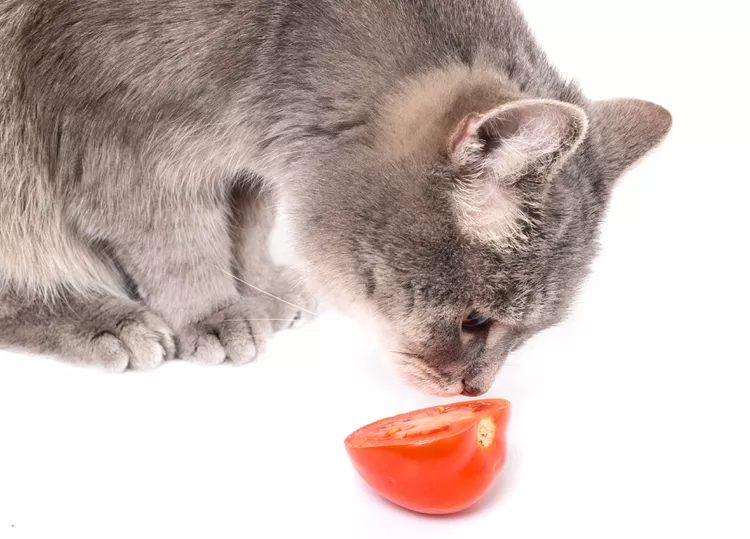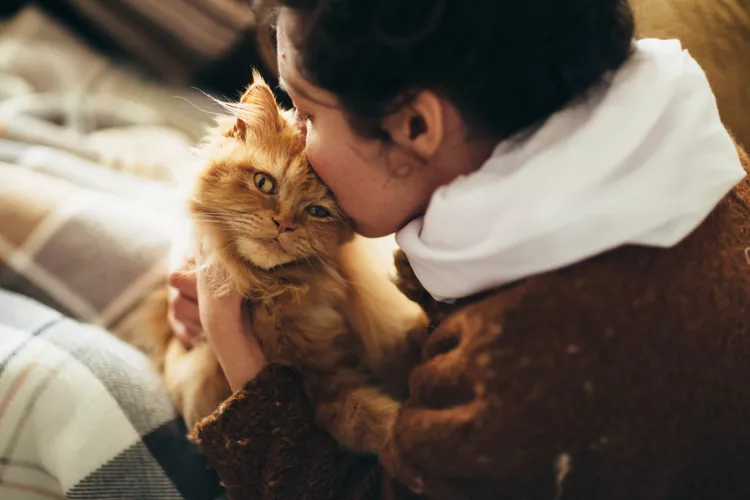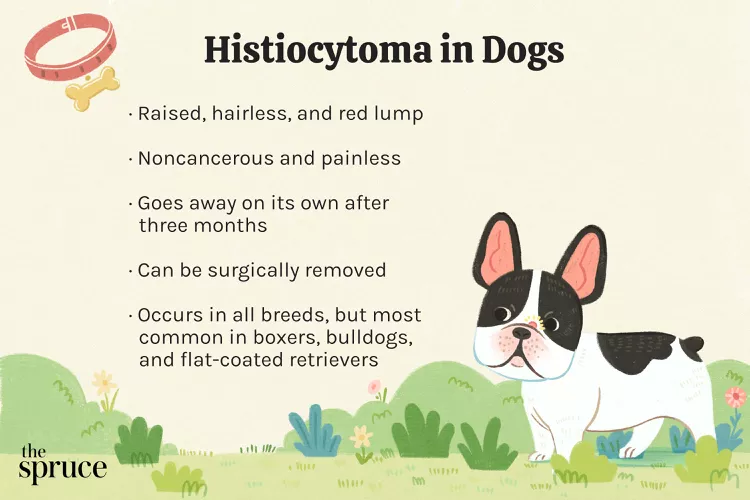
They say “curiosity killed the cat” because cats tend to want to check out everything in their environment, and sometimes cats do not know to avoid things that might harm them. If you are eating something, chances are your cat would like for you to share. As a practicing veterinarian, I am often asked about what human foods are safe to share with our cats, including if cats can eat tomatoes.
Cats are truly meat-eaters. In contrast with humans and dogs, cats are obligate carnivores. This means that at least 70 percent of their diet must be meat. Though cats will eat fruits, veggies, and grains, they do not require them. A cat cannot be a vegetarian or vegan.
Many owners wonder if they can or should feed “human” food to their cats. In general, a cat should derive all of their calories from high-quality, balanced cat food. However, giving a cat a treat can help strengthen the human-animal bond and may be used in training. Commercial cat treats may be offered, but small nibbles of food typically intended for humans may be used as well—as long as you know they are non-toxic to cats.
If tomatoes are on your menu, you may find that your cat is not interested, as most cats do not prefer this ruby-red fruit. But what if your cat does want to eat your tomato?
Tomatoes are a healthy fruit for humans, full of antioxidants and vitamins. Tomatoes are a great source of vitamins A, C, K, potassium, fiber, and lycopene, a compound found in high levels in tomatoes, that has been shown to have many health benefits for people.
With all of that being said about the health benefits of tomatoes for humans, it is a mistake to assume these properties hold true for cats eating tomatoes. Cats’ gastrointestinal systems are not designed to digest tomatoes, and if eaten in larger quantities, they may cause stomach pain, vomiting, or diarrhea.
It is important to note that green tomatoes that are not fully ripened, as well as their stems and leaves, pose a bigger danger to your cat. Unripened tomatoes and all parts of the tomato plant stem and leaves are toxic to cats. The toxic compound in these green parts of the plant is called solanine, and it is toxic to cats and many other animals. If a cat eats a tomato that is not ripened or the leaves or stems of a tomato plant, it may experience gastrointestinal distress, lethargy, a dangerously slow heart rate (bradycardia), and severe vomiting. Green tomatoes that have been cooked thoroughly are safer as they do not contain active solanine, however, they can still cause an upset stomach if eaten in large quantities.
If you have a cat that has a taste for tomatoes, you may safely feed them tiny amounts of the ripened flesh of the fruit from time to time. It is recommended that you limit the amount of tomato flesh eaten to just one or two bites, however. If larger quantities of the fruit are consumed by your cat, watch them carefully for any signs of gastrointestinal distress such as vomiting, stomach pain, or diarrhea. If any ill effects are seen, contact your veterinarian immediately.
In the case of sharing tomatoes with your cat, a few small nibbles of the ripened flesh of a tomato is likely not a cause for concern. However, not fully ripe tomatoes, stems, and leaves should definitely be avoided. If your cat eats any of the above, please contact your veterinarian right away.
Because cats are true carnivores and require that at least 70 percent of their diet be made up of meat, it is critical to ensure that they are being fed a meat-based diet. Treats should be kept to a minimum—no more than 10 percent of their total daily calories. If too many snacks or treats are given, the cat may become too full to then be able to ingest an adequate amount of its regular diet. This may lead to nutritional deficiencies and serious illness.
As always, if you have any questions or concerns about your pet’s health or what to feed your cat, you should always reach out to your veterinarian.

Cute Pictures & Facts About Calico Cats & Kittens
Learn fascinating facts about calico cats, including photos, the genetics behind this color combination, and common folklore and traditions.
How to Prevent Cat Separation Anxiety During Vacations
Discover why cats develop litter box problems and cat behavior problems when you go on vacation and what you can do about it to help them.
Cat Behavior Changes That Might Mean Something's Wrong
Cats' behavioral changes may indicate problems—or they may mean nothing at all. Explore causes of odd behavior and what to do about them.
Lhasa Apso: Dog Breed Characteristics & Care
The Lhasa apso is an ancient breed from Tibet that was bred to be a watchdog. Learn about its history, health, exercise needs, and more.
Reasons Why Dogs Run Away and How to Stop It
Dogs can escape, especially if they’re bored and not properly contained. Here are some techniques for stopping your dog from running away.
Can Dogs Get Depression? How to Help Your Sad Dog
Can dogs get depression? Learn about the signs of depression in dogs and find out how to help your sad dog.
How to Stop Aggression in Dogs
Dog aggression can be a serious behavior issue for pet owners. Learn how to stop aggression in dogs before someone gets hurt.
How to Stop Your Dog From Growling
A growling dog can soon become even more aggressive. Reduce the noise and potential for a dangerous situation with some of these techniques.
Why Do Dogs Dig Holes? How to Stop Your Dog from Relandscaping Your Yard
Dogs have been digging holes for centuries and for many reasons. Whether they’re bored or want to cool off in the dirt, here are the top reasons why dogs dig holes.
Dog Treat Varieties
Learn about the different types of dog treats on the market and decide which are best for your dog.
Can Dogs Eat Asparagus?
Dogs can eat asparagus, provided the vegetable is cooked plain and cut up for them. Seasonings, salt, and butter make it unhealthy for dogs.
Histiocytomas in Dogs
A histiocytoma is a type of benign (non-cancerous) skin lump that usually affects young dogs. Learn the causes, treatment, and prevention.
Why Is My Dog’s Eye Swollen?
If your dog's eye is swollen, she may need veterinary attention. The inflammation could be caused by allergies, an injury, or even a tumor.
Common Bugs and Parasites Found on and Inside Dogs
Learn about common types of parasites in dogs. Find out how to treat and prevent parasites to keep your dog, your family, and yourself safe.
Exploring the Different Types of Pet-Friendly Beaches
Are you looking for pet-friendly beaches? Learn about the different types of pet-friendly beaches, their locations, and tips for visiting them with your pet.
10 Obscure, Little-known Canine Facts in Honor of National Dog Day
With National Dog Day upon us, it's time to celebrate everything about our favorite pets—even the weirder stuff. Here are 10 obscure facts about dogs you probably didn't know.
Kitten Development From 3 to 6 Months Old
Kittens grow and change a lot during their first year. Find out what happens between the ages of three months and six months old.
95 Siamese Cat Names
Our list of Siamese cat names has diverse and fun options to help you choose the ideal moniker for your elegant and lovable feline companion.
What to Buy for Your New Cat: A List of Essentials
Before you bring your new cat or kitten home, there are a number of things to collect or buy so your cat will feel welcomed like a family member.
The 6 Best Cat Nail Clippers of 2024 for a Safe Trim
Clipping your cat's nails can save your furniture and keep your kitty comfortable. We asked veterinarians for their cat nail clipper recommendations.